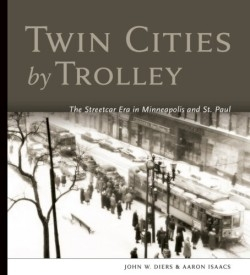Twin Cities by Trolley
The Streetcar Era in Minneapolis and St. Paul
Recently, the cities of Minneapolis and Saint Paul began developing a light rail system that would shuttle commuters, Twins baseball fans, and Mall of America shoppers across the metro areas. Plans to expand the lines are being embraced by legislators as well as frequent riders, who foresee an era when the light rail can stretch into suburbs and bring urban denizens to locales like Lake Minnetonka or Stillwater, a picturesque spot on the St. Croix River.
The introduction of the system is doing more than making the Twin Cities feel future-bound, however; its also reminding the cities of an era when such travel was a frequent pastime, thanks to an extensive trolley system.
Twin Citians of a certain age are fond of recalling how they packed picnic lunches and took a trolley to popular Sunday spots such aswhat a coincidenceLake Minnetonka and Stillwater. In their extensively researched and information-packed snapshot of the trolley lines, Twin Cities by Trolley, authors John Diers and Aaron Isaacs give a comprehensive look at a bygone era that contains plenty of lessons for the light rail riders of today.
The pair are well-qualified to dig deep into Twin City trolley history. Diers has served on the board of the Minnesota Transportation Museum, and worked in the states transit industry for more than thirty-five years, including twenty-five years for the Twin Cities Metropolitan Transit Commission (also known as Metro Transit). Isaacs has penned Twin City Lines: The 1940s and The Como-Harriet Streetcar Line, and worked for Metro Transit for thirty-three years.
The pairs love of the trolleys is apparent, as they chronicle the rise of a system that included more than 500 miles of track, and shaped the growth of the two urban areas. At its peak in the early 1930s, the Twin City Rapid Transit Company had over 900 streetcars, and carried more than 200 million passengers every year.
Beyond the numbers is a compelling history of how a city grows, and how transportation must be changed to accommodate ever larger numbers of residents.
The work is also a glimpse of urban change in the twentieth century. The streetcar, once beloved for its ability to deliver passengers to numerous destinations, began to be trumped by the automobile. Similar to what happened in other cities like Chicago and Philadelphia, commuters in Minneapolis and St. Paul began driving to work, and out to their Sunday destinations, creating traffic congestion that reduced streetcar speed and significantly increased operating costs.
In one of the more than 450 photographsmany provided by the Minnesota Historical Societythis situation is captured as early as the 1930s, with downtown streets clogged by both streetcars and automobiles. In addition to providing visual cues to the writing, the photographs are striking on their own, showing motormen, commuters, and routes. One charming photograph shows a motorman in 1938, in pillbox-type hat, beaming amid his whistle cord, transfer boxes, and air brake handle.
In creating a work that puts current transportation innovations into context, the authors have also preserved a slice of Twin Cities history, making sure that current riders can be connected to the past even as they barrel into the future.
Reviewed by
Elizabeth Millard
Disclosure: This article is not an endorsement, but a review. The publisher of this book provided free copies of the book to have their book reviewed by a professional reviewer. No fee was paid by the publisher for this review. Foreword Reviews only recommends books that we love. Foreword Magazine, Inc. is disclosing this in accordance with the Federal Trade Commission’s 16 CFR, Part 255.

